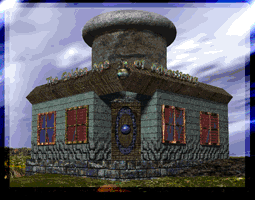The Story
In the opening animation, the player discovers that they have involuntarily become an agent of the Strategic Intelligence Alliance and have secretly received a brain implant.
and have secretly received a brain implant.
The SIA is dealing with the potential threat posed by a disappearing, reappearing building that bears the sign: "The Golden Age of Advertising".
Using the sign as a clue, an eccentric SIA researcher at the Institute of Worst-Case Studies applies a proprietary data-mining technique known as Implosive Paranoia Modeling and traces the phenomenon to an obscure scientist, Webster Wotsletter. Further, the modeling technique accurately predicts the location where the building will next appear.
the phenomenon to an obscure scientist, Webster Wotsletter. Further, the modeling technique accurately predicts the location where the building will next appear.
The player, now an agent of the SIA, is sent there.
In fact, the building is a temporal-dimension transporter. Upon entering it, the player should note the name "Uber" on the door.
Once inside, the player is introduced to the theory of shifting temporal perception (the Burma-Shave Analogy), and learns a bit about Webster's career and family. Curiously, his five sons, Royal, Silo, Tat, Uber and Vkoda, were all born at precisely the same instant. Apparently, "The Golden Age of Advertising" is the personal transporter of Webster's son Uber.
From here the player is transported to the Shave, the central location of the adventure and the home base of Webster and his sons. In the Shave, the player must solve large integrated puzzles to gain access to the various transporters of the remaining sons. The player uses these transporters to travel to other puzzle environments.
Script for The Burma-Shave Analogy
Our perception of reality can be compared to a clever advertising practice originated by the marketers of Burma Shave in the mid 20s. A single message was split into smaller fragments presented on a number of signs posted a considerable distance apart along an interstate highway.
For the purpose of our analogy, consider the messages the full extent of perceived reality. The highway, surrounding landscape and all other elements beyond the signs represent a transcendent reality beyond perception. Thus each sign is a perceptual unit-of-now. So among a nearly infinite number of absolute units-of-now, a very small set are perceived and as those units are pasted together into a coherent message, a reality is created.
elements beyond the signs represent a transcendent reality beyond perception. Thus each sign is a perceptual unit-of-now. So among a nearly infinite number of absolute units-of-now, a very small set are perceived and as those units are pasted together into a coherent message, a reality is created.
We share this reality because we perceive units-of-now starting from the same offset and at the same frequency.
What would happen if we changed the offset or frequency or both?
One might expect the greater reality of absolute units-of-now to be coherent in a way consistent with our perceived reality. If this were true then increasing the frequency would result in a slowed version of current reality. However, this is not the case. Coherency is strictly derived from the message that emerges as the fragments are perceived and as their adjacencies are rationalized. The process is much like an assortment of adjectives acting on a single noun. Consider how all of the following rationalize into a different image:
- Fat man
- Dead man
- Small man
- Strong man
- Invisible man
In a like fashion, changes in the offset, frequency or both result in a new mix of perceptual units-of-now with new and unique adjacencies and rationalize into a reality of meaning and content vastly different from all others.